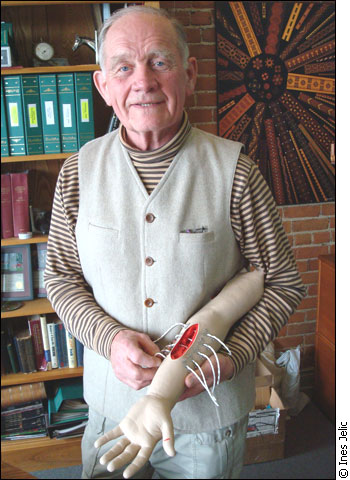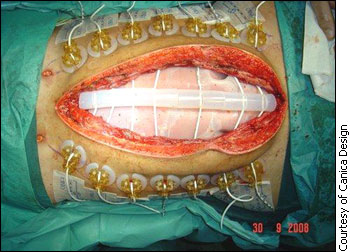It began with “the world’s best scalpel,”
a scalpel shaped like a carving knife but with the functional
capability of a retractable Exacto knife, according to Michael
Bell, a plastic surgeon at the Ottawa Hospital.
After years of research, development and a seven-figure
investment in the company, Bell and the company’s founder,
Leonard Lee, started making medical products and systems
they say are more successful than more conventional medical
devices.
 |
| Leonard Lee, age 71, has designed
some of the most innovative new medical products on the
market. |
“We have produced products that are stunningly good
at what they do,” says Lee.
Cutting edge technology
The focus of the designs is the manipulation of a patient’s
skin with the use of mechanical devices to facilitate complex
operations.
Probably the most innovative of Lee’s designs is the
dynamic wound closure system.
The system consists of one of three different types of anchors:
adhesive, skin and button. Different anchors are used depending
on the tension of the skin on either side of the wound. Elastic
silicone cords are fed through a wire cleat that is attached
to the anchors. The cord, which is called an elastomer, can
be laid over the skin or inserted through the skin like sutures
for better grip. The elastomers are labeled with black lines
to indicate the level of tension that is put on the wound.
The elastomers are tightened every three to four days until
the two sides of the incision meet and heal or are stitched
or stapled together. This process can be compared to tightening
a corset. The only difference is that while a corset uses
one string to connect all points, the wound closure system
uses an elastomer for every entry point on either side of
the wound.
| 'You can't measure
the value of being able to close an abdomen.' |
By attaching the anchors and using elastomers the surgeon
is able to slowly stretch the skin that retracts upon creating
an incision, and pull it together.
Previously, it would take two weeks to stabilize the wound
and one year to heal says Bell.
But, with the Canica system, it takes less than three days
to close a medium-sized incision.
Prior to this system, plastic surgeons would use tension
sutures, which were prone to ripping skin because of the
high tension of the retracted skin, or rely on skin grafts
to patch the open wound rather than closing it.
Bell says
that with old techniques “the
person is crippled with a chronic hernia.”
But, with the wound closure system, Bell says that “you
can’t measure the value of being able to close an open
abdomen. The patient walks out of the hospital without a
skin graft, without the need for another operation and without
a painful donor site.”
Canadian innovation vs. implementation
Despite the benefits, the problem facing Lee is the lack
of acceptance of his products by many surgeons, hospitals,
and the health care system.
|
Warning: Surgical photographs are graphic in nature. Viewer discretion is advised. |
Requires
FlashPlayer  |
|
Julia Barry, the manager of clinical and regulatory
affairs at Canica says that trying to convince people within
the health care system to incorporate their products is difficult.
She says despite extensive research and practical proof
in war zones of the efficacy of Canica products, the lack
of a drive towards accepting new technologies and systems
by surgeons is making it difficult to conduct proper and
objective research that would be accepted by the health care
system.
Lee admits he didn’t consider the difficulty in
trying to change the current practice in medicine.
He says that the health system and the hospital budgeting
structure make it difficult, because money cannot be transferred
between departments, or taken from equipment or patient
care costs.
The cost of the system would have to be paid by the department
where it is used, usually in the operating room, but the
benefits would only be visible in intensive and home care.
 |
| Wound closure
systems manipulate the elasticity of the skin in order
to allow the closing of the wound with less scarring. |
But Bell explains that “you almost eliminate home
care, because the patient can walk out of the hospital with
this system on.”
At the Ottawa Hospital, Civic campus, surgeons using the
system estimated that the average patient cost saving where
a Canica device was used was $8,000, 10 times the cost of
the system itself.
Still, Lee says that the systems are not used continuously
in any other hospital in the city.
The American health care system on the other hand provides
monetary incentives for surgeons who use Canica products,
because of the cost savings. This is contrary to Canada,
where incentives are not given and surgeons are reluctant
to change their ways because of the extra training the new
technologies would require.
Lee and Bell agree that as young surgeons who are more welcoming
to change phase out their predecessors, Canica products will
catch on faster because they will become the norm.
For now, Canica Design research and development has halted,
but Lee and his team are working on getting their products
licensed so they can be used more widely in hospitals in
Canada and around the world.
Like any good medical device, Bell says, “it takes
time to catch on.”
|

